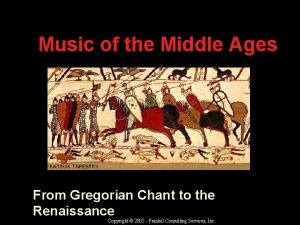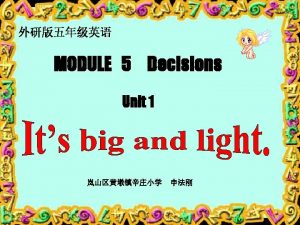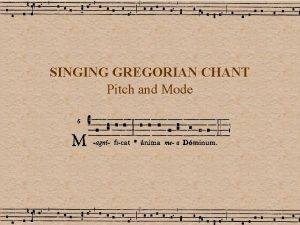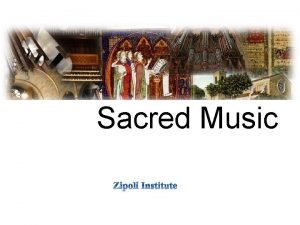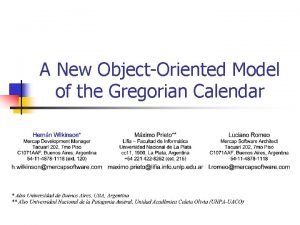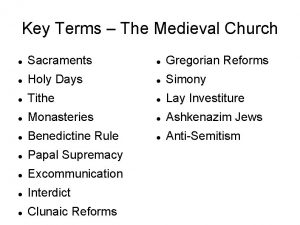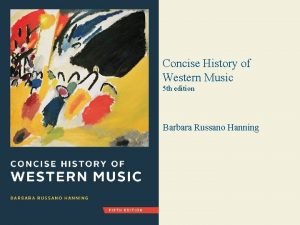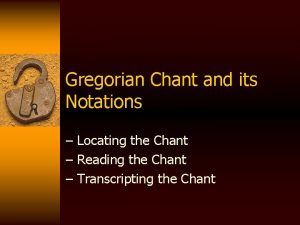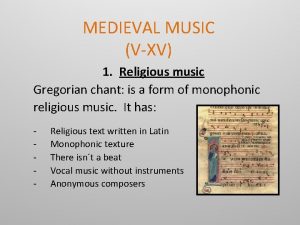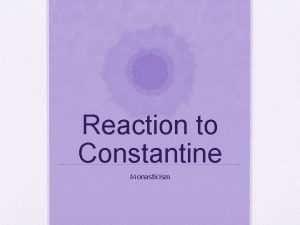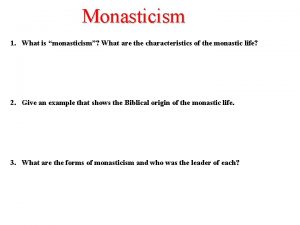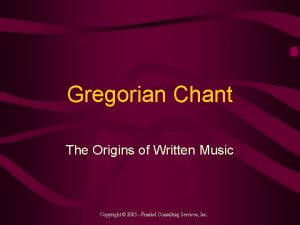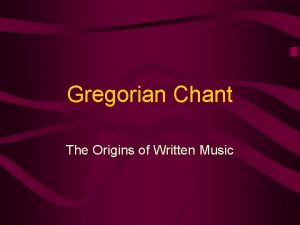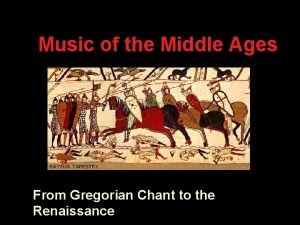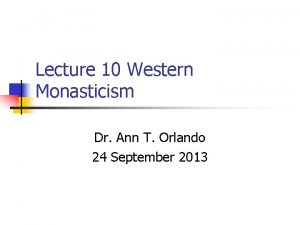Episode 6 Early Western Monasticism Music Gregorian Chant
















- Slides: 16

Episode 6: Early Western Monasticism Music: Gregorian Chant and/or St. Patrick’s Hymn 1

TIMELINE • Theme: two monastic developments that evangelized Europe and preserved ancient education after fall of Roman Empire in the West 2

Religious and Educational Light in the Darkness: European Monasteries • Irish Monasticism • Benedictines 3

Waypoint: Iona Scotland • Iona is an island off west coast of Scotland • Early expansion of Irish monasticism – Founded by St. Columba c. 563 • Iona quickly became leading center of Irish monasticism – Center of learning – Important scriptorium – Missionary activities to England Northern Europe 4

Irish Church • Ireland never part of Roman Empire; – not affected by 5 th, 6 th C barbarian invasions • St. Patrick (d. 490) returned to Ireland from England after having been a slave in Ireland to preach Christianity – Organizes parishes around monasteries – Makes Latin the scholarly language in Ireland – Feast day, March 17 • Irish monasteries are cutoff from Roman world due to barbarian invasions, develop different customs – Different calculation for Easter – Discipline (penance, private confession) – Organization: abbots rather than bishops • In early Sixth Century Irish monks led by St. Columba establish a monastery at Iona, Scotland 5

6 th C Italian Monastic Developments • St. Benedict of Nursia (480 -547) – Greatly influenced by St. Pachomius – Established an order of Monks, now known as Benedictines, governed by his Rule – Feast Day July 11 • Sister, Scholastica, founded an order of nuns to follow the Rule – Feast Day February 10 • Most popular religious order in West until 13 th C 6

Waypoint: Monte Cassino • Monastery established by St, Benedict c. 530 – High mountain outside of Rome to try to remove monks from war between Justinian and German barbarians – Benedict died at Monte Cassino in 543 • Monks lived by Benedict’s Rule • Benedictines and various offshoots dominated Western monasticism 7

Development of Christian Monasticism: Egyptian Monasticism Early 4 th C • Desert Monks (from Greek for solitary), primarily in Egypt: anchorites withdrawn from society – Most famous: Anthony (251 -356), – St. Athanasius, Bishop of Alexandria, wrote a very influential life of Anthony, example: Augustine Confessions Book VIII • Communal monasticism – Many attracted to this way of life, come together in groups – Rule of St. Pachomius (286 – 346) – Pachomius’ sister, Mary, established an Egyptian monastery for women with their own Rule 8

What’s a Rule • Prescribes the way of life for the community • Includes what prayers are said when • Defines balance between work, study, prayer • Community organization (abbot, monks, novices) and how leaders are selected • Process for acceptance into community • How new communities are created • Relation between community and diocese 9

Key Historical Events 5 th Century • Increasingly West was under pressure from northern tribes (Goths, Visigoths, Vandals) • Goths sacked Rome in 410 – St. Augustine dies in 430 as Hippos is besieged by Vandals • Center of power in Roman Empire is only in Constantinople • Attila the Hun reaches Rome in 452, persuaded by Pope St. Leo the Great not to sack Rome • Last Roman emperor in West abdicated in 476 • Europe enters a period ruled by warring Germanic tribes – Tremendous social and cultural disruption 10

6 th and 7 th Century Monastic Missionary Activities in Western Europe • • Parallel, independent missionary activities from Rome and Ireland (Iona) Irish monks in 6 th Century travel far beyond Ireland as missionaries to preach Christianity – St. Columban(us) travels extensively through Europe establishing Irish style monasteries, including one in Northern Italy (d. 615) – St. Brendan the Navigator may have reached Iceland, Greenland perhaps North America Meanwhile, missionaries from Rome are also trying to convert Pagan Germanic tribes – Conversion of Chlodwech (Clovis), King of the Franks, 496 – Pope St. Gregory the Great sends St. Augustine of Canterbury (a Benedictine) to England 597 Differences between Irish and Roman Churches resolved at Synod of Whitby, 664, in favor or Roman customs 11

Map of Early Monasteries 12

The Pope Who Brought the Two Monastic Movements Together: Pope St. Gregory the Great • Pope St. Gregory Great (546 -604) – Benedictine – Wrote a life of Benedict • Reformed Roman clergy around monastic model • Reformed the liturgy and Church music • Encouraged Irish monks, St. Columbanus, to found monasteries in northern Italy • Earliest extant life of Gregory written by an English nun, 8 th C • Feast Day is September 3 13

Later Monastic Developments • Revitalization of Benedictine monasticism during the Middle Ages – Cluniac Reforms of 10 th C – Cistercian Reforms of 11 th C • Monasteries were primary locus of education for boys and girls until later Middle Ages • Monastic orders continue to live a life of Christian witness – Benedictines – Cistercians – Trappists 14

Later History of Iona and Monte Cassino • Both destroyed by warfare • Iona destroyed by Vikings in 9 th C – Recent excavations and a popular tourist site • Monte Cassino destroyed by Allied forces in 1943 – Rebuilt after WWII, reconsecrated by Pope Paul VI in 1964 15

Next Waypoint: Aachen Cathedral 16
 Gregorian chant timbre
Gregorian chant timbre Gregorian chant middle ages
Gregorian chant middle ages Listen and chant
Listen and chant Podatus gregorian chant
Podatus gregorian chant Sacred gregorian chant
Sacred gregorian chant Bhakti movement definition ap world history
Bhakti movement definition ap world history Monasticism in islam
Monasticism in islam Music music music
Music music music Gregorian calendar 2019
Gregorian calendar 2019 Clunaic
Clunaic Staff note symbol
Staff note symbol Characteristics of india music
Characteristics of india music Concise history of western music 5th edition
Concise history of western music 5th edition Western music periods
Western music periods Early cpr and early defibrillation can: *
Early cpr and early defibrillation can: * Philippine music during american and japanese period
Philippine music during american and japanese period What music that employs electronic music?
What music that employs electronic music?

